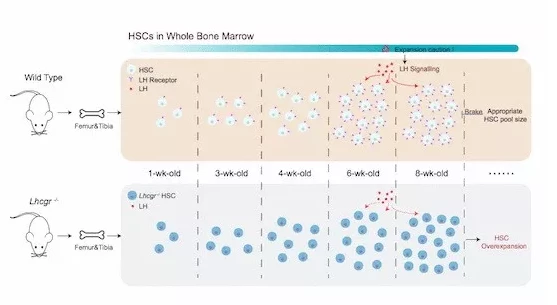Studies reveal important regulatory functions of LH signaling in the regulation of hematopoietic stem cell homeostasis

Studies reveal important regulatory functions of LH signaling in the regulation of hematopoietic stem cell homeostasis

Copyright © iCell Bioscience Inc, Shanghai 2018-2019
On July 23rd, The EMBO Journal published the latest issue of "Luteinizing hormone signaling restricts hematopoietic stem cell expansion during puberty" in collaboration with the Zhou Bo Research Group of the Institute of Biochemistry and Cell Biology of the Chinese Academy of Sciences and the Zheng Junke Research Group of Shanghai Jiaotong University. Research results. This work reveals for the first time an important regulatory function of luteinizing hormone (LH), a secretory hormone secreted by puberty, in the steady state maintenance of hematopoietic stem cells (HSC).

Like tumor cells, stem cells have the potential to proliferate in vivo; but unlike tumor cells, the number of adult stem cells in each tissue is tightly regulated, which is called the counting mechanism of adult stem cells. This metering mechanism has been confirmed in a variety of adult stem cells. However, until now, the molecular basis of the body's implementation of this metering mechanism remains unclear, and the biological significance of the metering mechanism is unknown.
Hematopoietic stem cells are a class of adult stem cells that are self-renewing and have the potential to differentiate into the cellular potential of all hematopoietic lineages. At different developmental stages, the function of hematopoietic stem cells is tightly regulated, and many pathways participate in this regulation process in a cellular autonomy. In recent years, studies have found that exogenous factors also play a crucial role in the steady state maintenance of hematopoietic stem cells. Mesenchymal stem cells and endothelial cells in the hematopoietic stem cell microenvironment can secrete a variety of cytokines including SCF and CXCL12 to regulate hematopoietic stem cell homeostasis.
Unlike the SCF and CXCL12 signals in the hematopoietic microenvironment, luteinizing hormone is not derived from the vicinity of hematopoietic stem cells. This systemic sex hormone is secreted by the distal pituitary gland. As an upstream molecule of sex hormones, the "home job" of luteinizing hormone is involved in regulating the maturation of the male and female reproductive systems.
The researchers described another novel function of luteinizing hormone, which regulates the homeostasis of bone marrow hematopoietic stem cells in adolescent mice. Studies have shown that after birth, HSC in the bone marrow of mice enters a high-speed expansion phase, and with the onset of puberty in mice, this development progresses into the "brake brake" phase, and the number of HSCs gradually stabilizes. At this stage, the expression level of luteinizing hormone receptor (Lhcgr) on the bone marrow HSC surface also showed a significant increase.
Through various experimental methods such as immunofluorescence and flow cytometry, it was further found that luteinizing hormone receptor was directly expressed in HSC and highly enriched in HSC group. Based on these early findings, a downstream related phenotypic analysis was performed using the Lhcgr knockout mouse model. The results showed that blocking of LH signal resulted in over-expansion of HSC in the bone marrow of adult mice and abnormal increase in peripheral blood leukocytes.
This evidence directly demonstrates that LH signaling plays a key role in regulating HSC function. In addition, Lhcgr knockdown was also found in the MLL-AF9-induced acute myeloid leukemia model to accelerate the onset of leukemia.
The research team used Lhcgr knockout mice to directly verify the regulation of LH signaling. Based on gonadal ablation and HSC transplantation, the LH signal regulation function was not dependent on the downstream sex hormones, nor on the stem cell microenvironment. It is demonstrated that the LH signal plays a corresponding regulatory role through the direct target of HSC.
This work is the first to propose a measurement mechanism for HSC - the pituitary gland allows the number of HSCs to achieve homeostasis during puberty by secreting LH. Once the HSC LH signal is blocked, HSCs in the bone marrow continue to expand during puberty, eventually leading to bone marrow over-hematopoiesis and leukocytosis, accompanied by an acceleration of the leukemia process. Therefore, this paper also reveals for the first time the physiological significance of stem cell metrology, maintaining normal hematopoiesis and inhibiting leukemia progression.
 Loading ....
Loading ....
